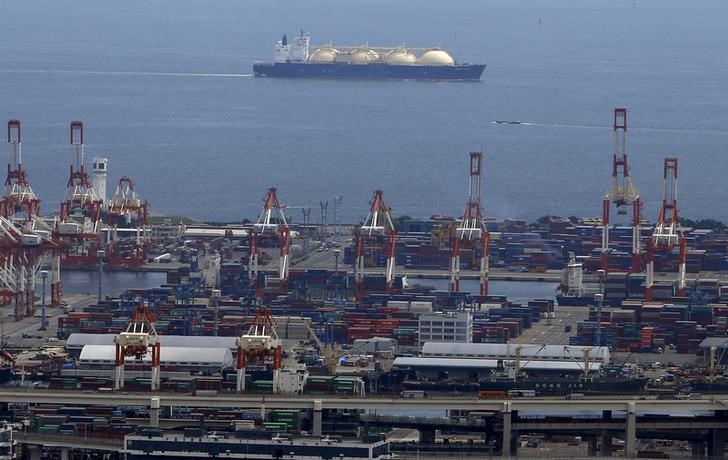(The opinions expressed here are those of the author, a columnist for Reuters.)
By Clyde Russell
LAUNCESTON, Australia, Aug 17 (Reuters) - Should the arrival of the last major piece of kit in Australia's $180 billion liquefied natural gas (LNG) spree be a cause for celebration or for a wake?
It may seem that the arrival of the Ichthys Venturer floating production, storage and offloading facility would be worthy of breaking out the champagne.
The vessel, which will be moored some 220 kilometres (132 miles) off the northwestern coast as part of Inpex's Ichthys project, is the final piece of the jigsaw that completes eight massive new LNG ventures. projects, when in full production, will see Australia overtake Qatar as the world's largest producer of the super-chilled fuel, and become an energy export superpower when one considers the country is already the world's biggest shipper of coal and a significant producer of uranium.
While these accomplishments are worthy of a toast or two, there are also factors that serve to put a dampener on the party.
The first is that Australia's rise to the top of the global LNG tree may be short-lived, as Qatar has announced plans to boost its output beyond the 85.7 million tonnes of LNG capacity already operating or scheduled to start up by the end of next year.
Qatar announced on July 4 it planned to raise its capacity by 30 percent, which would take it to around 100 million tonnes per annum, enough to take back the crown from Australia.
The problem for Australia is not the loss of prestige, it's the fact that Qataris are able to boost capacity by doing brownfield expansions of existing facilities, which is considerably cheaper than building new projects from scratch.
No new LNG project has reached a final investment decision in Australia since 2012, even though at one stage there were five ventures with a capacity of 31.5 million tonnes a year under consideration.
The collapse in spot Asian LNG prices LNG-AS to the current $6.20 per million British thermal units (mmBtu) from over $20 at the start of 2014 has no doubt played a part in delaying, or cancelling projects.
However, there is some hope on this front that by the mid-2020s the LNG market will move from its current oversupplied state back to deficit, mainly as the result of new consumers in countries such as Sri Lanka and Bangladesh, as well as growth in major markets like China.
NEW THINKING NEEDED
This means a developer with some confidence that LNG demand will grow in the coming years would have to be looking at sanctioning a new project soon, or risk losing out to competitors.
Having led the last LNG boom, it seems odd that Australia is possibly in one of the weakest positions to be part of any new wave of development.
This is especially the case since nothing that made Australia so attractive has really changed.
The country still has low sovereign risk, a well-established legal system, a skilled workforce, generally supportive political leaders and a robust regulatory system.
But the weaknesses that become apparent during the massive building boom of the last seven years are still present.
These include high-costs of developing new projects given their remoteness, the workforce is skilled but pricey with some of the highest wages in the industry, compliance costs are high and there has been a small ratcheting up of the political risk.
The federal government of Prime Minister Malcolm Turnbull has instigated what is essentially a natural gas reservation policy, under which it can direct natural gas away from LNG plants to the domestic market if it feels the domestic price has risen too high.
While it's likely that this mechanism will be seldom used, it is a factor that is off-putting to potential investors.
But far more important than the politics is the economics, and it seems that large-scale, multi-billion dollar projects are increasingly hard to justify in an era of lower prices.
This means that Australia, if it is to compete with Qatar's brownfield, low-cost expansion, will have to become more innovative.
Several suggestions were put forward by Deloitte Australia's oil and gas leader Bernadette Cullinane at the South East Asia Australia Offshore and Onshore Conference in Darwin on Wednesday.
Among the key points raised was the need for oil and gas companies to collaborate on new projects, rather than going it alone as has been the case in the current construction boom.
Saving capital by using more floating LNG platforms and sharing resources was another point made by Cullinane.
But perhaps the most important point was whether Australia should consider adopting the U.S. model of tolling and fixed liquefaction fees.
This would allow some companies to develop natural gas fields and others to build liquefaction units and charge a fee for turning the gas into LNG.
That would cut down on the capital intensity of developing new projects and allow for more joint ventures to share costs and risks.
While there has been some talk of this in the industry in Australia, this sort of cooperation seems far from imminent.
This means Australia may well fall behind projects in East and West Africa, Russia, Canada and the United States when it comes to the next generation of LNG.
<^^^^^^^^^^^^^^^^^^^^^^^^^^^^^^^^^^^^^^^^^^^^^^^^^^^^^^^^^^^ GRAPHIC on global LNG demand
http://reut.rs/2hj4ymU
^^^^^^^^^^^^^^^^^^^^^^^^^^^^^^^^^^^^^^^^^^^^^^^^^^^^^^^^^^^> (Editing by Joseph Radford)
